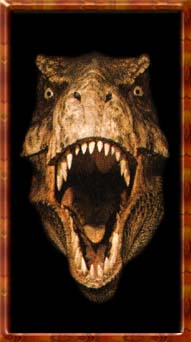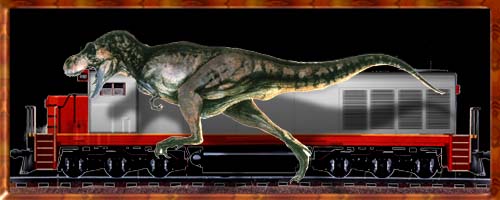Dinosaur Profile
Tyrannosaurus rex
"Tyrannosaurus"
(Greek tyrannos
= "ruler" + Greek sauros = "lizard")
Also known as "T-Rex"
Size:
13 meters (42 feet)
Period:
Late Cretaceous (68 million to 65 million years ago)
Place:
Colorado, Wyoming, Montana, South Dakota, New Mexico, Mongolia,
China
 Originally believed to
be the most dangerous hunter ever to have walked the earth, the
T-Rex has lived up to expectations. An enormous skull (approximately
1.5 meters, or 4.5 feet) contains a powerful set of dagger-shaped
teeth, measuring 8 to 16 centimeters (3 to 6 inches) in length
and 2.5 centimeters (1 inch) wide. Its extremely functional arms
(90 centimeters, or about 3 feet long) can lift weights approaching
500 pounds, and the highly-developed legs allow the creature to
run nearly 25 miles per hour. Add the incredibly developed senses
- including binocular vision, superior hearing and a keen sense
of smell - and one begins to believe all of the hype.
Originally believed to
be the most dangerous hunter ever to have walked the earth, the
T-Rex has lived up to expectations. An enormous skull (approximately
1.5 meters, or 4.5 feet) contains a powerful set of dagger-shaped
teeth, measuring 8 to 16 centimeters (3 to 6 inches) in length
and 2.5 centimeters (1 inch) wide. Its extremely functional arms
(90 centimeters, or about 3 feet long) can lift weights approaching
500 pounds, and the highly-developed legs allow the creature to
run nearly 25 miles per hour. Add the incredibly developed senses
- including binocular vision, superior hearing and a keen sense
of smell - and one begins to believe all of the hype.
Environment:
The original plan was to insert the T-Rex in the plains and semi-arid
regions, as the Park's designers hoped to impress crowds with
its dazzling hunting abilities. The beast has proven to be a bit
of a disappointment in the showmanship department, however, tending
to conceal itself in the forest.
Feeding:
Adding to this disappointment is the realization that, when able,
the carnivorous T-Rex prefers to scavenge the remains of dead
meat rather than hunting for fresh prey.
 Habits:
Despite all the trappings, the T-Rex has repeatedly demonstrated
a kindly nature. Seemingly content to dine on carcasses in the
quiet seclusion of the forest, the T-Rex has turned out to be
Jurassic Park's unlikely model citizen.
Habits:
Despite all the trappings, the T-Rex has repeatedly demonstrated
a kindly nature. Seemingly content to dine on carcasses in the
quiet seclusion of the forest, the T-Rex has turned out to be
Jurassic Park's unlikely model citizen.
Ops Notes:
While the T-Rex has failed to live up to its original (and overly
optimistic) expectations, the Genetics Division maintains high
hopes of effecting a serious attitude adjustment. Recent efforts
have concentrated on increasing the creature's visibility.
Brachiosaur | Compy
| Dilophosaur | Gallimimus
| Parasaur
Psittacosaurus | Triceratops
| Tyrannosaurus | Velociraptor
| Exit
Copyright � 1996, Universal City Studios, Inc.
Web site designed by Z.M.Interactive.
 Originally believed to
be the most dangerous hunter ever to have walked the earth, the
T-Rex has lived up to expectations. An enormous skull (approximately
1.5 meters, or 4.5 feet) contains a powerful set of dagger-shaped
teeth, measuring 8 to 16 centimeters (3 to 6 inches) in length
and 2.5 centimeters (1 inch) wide. Its extremely functional arms
(90 centimeters, or about 3 feet long) can lift weights approaching
500 pounds, and the highly-developed legs allow the creature to
run nearly 25 miles per hour. Add the incredibly developed senses
- including binocular vision, superior hearing and a keen sense
of smell - and one begins to believe all of the hype.
Originally believed to
be the most dangerous hunter ever to have walked the earth, the
T-Rex has lived up to expectations. An enormous skull (approximately
1.5 meters, or 4.5 feet) contains a powerful set of dagger-shaped
teeth, measuring 8 to 16 centimeters (3 to 6 inches) in length
and 2.5 centimeters (1 inch) wide. Its extremely functional arms
(90 centimeters, or about 3 feet long) can lift weights approaching
500 pounds, and the highly-developed legs allow the creature to
run nearly 25 miles per hour. Add the incredibly developed senses
- including binocular vision, superior hearing and a keen sense
of smell - and one begins to believe all of the hype.
 Habits:
Despite all the trappings, the T-Rex has repeatedly demonstrated
a kindly nature. Seemingly content to dine on carcasses in the
quiet seclusion of the forest, the T-Rex has turned out to be
Jurassic Park's unlikely model citizen.
Habits:
Despite all the trappings, the T-Rex has repeatedly demonstrated
a kindly nature. Seemingly content to dine on carcasses in the
quiet seclusion of the forest, the T-Rex has turned out to be
Jurassic Park's unlikely model citizen.